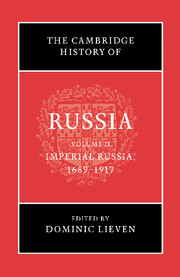Book contents
- Frontmatter
- Introduction
- Part I Empire
- Part II Culture, Ideas, Identities
- 4 Russian culture in the eighteenth century
- 5 Russian culture: 1801–1917
- 6 Russian political thought, 1700–1917
- 7 Russia and the legacy of 1812
- Part III Non-Russian Nationalities
- Part IV Russian Society, Law and Economy
- Part V Government
- Part VI Foreign Policy and the Armed Forces
- Part VII Reform, War and Revolution
- Bibliography
- Index
- Map 5. The Russian Empire (1913). From Archie Brown, Michael Kaser, and G. S. Smith (eds.) Cambridge Encyclopedia of Russia 1982.">
- Plate Section">
- References
4 - Russian culture in the eighteenth century
from Part II - Culture, Ideas, Identities
Published online by Cambridge University Press: 28 March 2008
- Frontmatter
- Introduction
- Part I Empire
- Part II Culture, Ideas, Identities
- 4 Russian culture in the eighteenth century
- 5 Russian culture: 1801–1917
- 6 Russian political thought, 1700–1917
- 7 Russia and the legacy of 1812
- Part III Non-Russian Nationalities
- Part IV Russian Society, Law and Economy
- Part V Government
- Part VI Foreign Policy and the Armed Forces
- Part VII Reform, War and Revolution
- Bibliography
- Index
- Map 5. The Russian Empire (1913). From Archie Brown, Michael Kaser, and G. S. Smith (eds.) Cambridge Encyclopedia of Russia 1982.">
- Plate Section">
- References
Summary
Russia and the West: ‘catching up’
Two edicts issued within a few weeks of each other offer a foretaste of the trajectory of Russian culture in the eighteenth century. At the end of December 1699 Peter I replaced the Byzantine practice of counting years from the creation of mankind with numbering from the birth of Christ, ‘in the manner of European Christian nations’. Henceforth the year would begin in January, not September. On 4 January 1700 townsmen were ordered to adopt Western dress, a decree that was extended later in the year to women. In both cases, Peter’s potentially recalcitrant subjects were provided with visual aids: examples of New Year festive greenery and mannequins wearing ‘French and Hungarian’ dress were displayed in public places to prevent anyone ‘feigning ignorance’ about what was required. Both these measures presupposed ‘Christian Europe’ as Russia’s model. Both offended Orthodox sensibilities. Traditionalists protested that Peter was tampering with Divine time and that the ‘German’ dress and the clean-shaven faces imposed on men a few years earlier were ungodly. Elite Russians in Western fashions entered a Western time scale, while the mass of the traditionally clad population, who had little need to know what year it was, continued to live by the cyclical calendar of feasts and saint’s days. Historians agree that these and subsequent reforms widened the gap between high and low culture: the elite ‘caught up’ with the West, while the lower classes ‘lagged behind’.
Keywords
- Type
- Chapter
- Information
- The Cambridge History of Russia , pp. 65 - 91Publisher: Cambridge University PressPrint publication year: 2006



